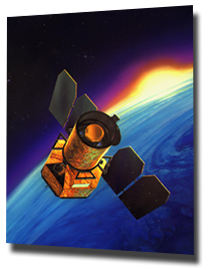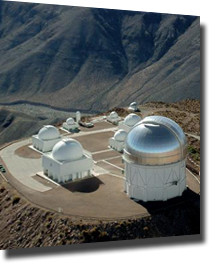1. Research with GALEX
Galaxy Evolution Explorer (GALEX) is NASA's space UV telescope, mapping the whole sky in UV for the first time. Benefiting from unprecedented power of GALEX to look into young stars, we are investigating the conditions that promote/hinder the birth of new stars within galaxies.


2. Research with the Ground-Based Telescopes
We have joined partnership of Cerro Tololo Inter-American Observatory (CTIO), a division of National Optical Astronomy Observatory (NOAO), 4m telescope since 2006. We have also carried out observation with Subaru 8m telescope, operated by National Astronomical Observatory of Japan (NAOJ), since 2007. Using these large ground-based telescopes, we are exploring the nature of various stellar systems, from star clusters to galaxy clusters.
3. Research with N-body Simulations
(1) The Milky Way Family
The Milky Way has about a dozen satellite dwarf galaxies and some 150 globular clusters. How are they linked to each other? Clarification of this issue is of very high relevance for modern cosmological theory. We study various aspects of the dynamical evolution of the Milky Way satellites and globular clusters.
(2) The Galactic Encounters
Galaxies collide! This energetic event often changes permanently the shape of the galaxies involved. For instance, spiral galaxies have thick disks (with a scale height of about 1 kpc) along with the thin disk (with a scale height of about 250 pc). Various formation scenarios for the thick disk exist, one of them being the collision with other galaxies. Another merger remnant may include the boxy/peanut-shaped bulges often found in local edge-on disk galaxies. Using N-body simulations, we explore the deep impact that the galactic encounters may have on galaxies.
The Milky Way has about a dozen satellite dwarf galaxies and some 150 globular clusters. How are they linked to each other? Clarification of this issue is of very high relevance for modern cosmological theory. We study various aspects of the dynamical evolution of the Milky Way satellites and globular clusters.
(2) The Galactic Encounters
Galaxies collide! This energetic event often changes permanently the shape of the galaxies involved. For instance, spiral galaxies have thick disks (with a scale height of about 1 kpc) along with the thin disk (with a scale height of about 250 pc). Various formation scenarios for the thick disk exist, one of them being the collision with other galaxies. Another merger remnant may include the boxy/peanut-shaped bulges often found in local edge-on disk galaxies. Using N-body simulations, we explore the deep impact that the galactic encounters may have on galaxies.


4. Formation and Evolution of Galaxies
There are such a large number of galaxies out there in the vast Universe. How did they form? And how have they evolved? That is one of our scientific goals. Using UV data from GALEX, we have found a large number of early-type galaxies with significant enhancement in UV flux. We are exploring the nature of conditions of star formation in galaxies.
5. Star Clusters of the Milky Way and External Galaxies
Over several thousands of star clusters are buzzing around a giant galaxy, and our own Milky Way galaxy is leading an army of hundreds star clusters. Star cluster systems play a key role in uncovering the galaxy assembly and star formation histories of galaxies. In the light of their traits revealed by high-end observing facilities in orbit and on the ground, we are attacking the astrophysical conundrum of when and how they formed, how they have evolved, and how they are linked to their host galaxies.
